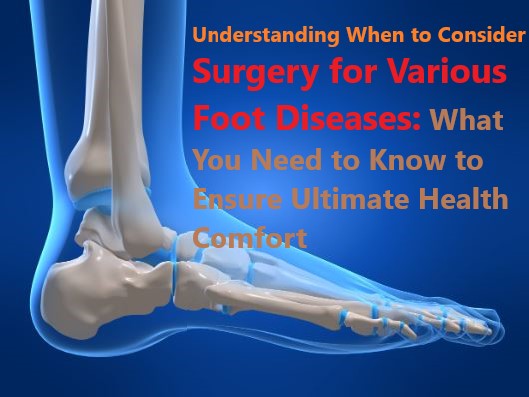Discover the crucial factors determining when surgery becomes necessary for different foot ailments. Gain insights into ensuring optimal health and comfort through informed decision-making.
Table of Contents
Exploring surgical options for severe foot problems is a crucial step for Anyone. Individuals are facing persistent pain, deformities, or injuries that have not responded to conservative treatments. Surgery can offer relief, restore function, and improve the quality of life. The surgery can be blessed for those suffering from a range of severe foot conditions. This article delves into the reasons for considering foot surgery, common surgical procedures, and what to expect during recovery.

Reasons for Considering Foot Surgery
When exploring surgical options for severe foot problems, understanding the underlying reasons that may necessitate such intervention is crucial. These reasons vary widely, encompassing chronic conditions, structural deformities, and injuries that impact the quality of life. Here’s a closer look at each reason, providing deeper insights into why surgery might be considered:
Chronic Pain
Non-Responsive to Conservative Treatments: Chronic foot pain often leads to surgery when it persists despite comprehensive conservative treatments such as physical therapy, medication, orthotics, and lifestyle modifications.
Impact on Quality of Life: Persistent pain can significantly affect an individual’s ability to perform daily activities. They cant easily engage in exercise, and even maintain employment in some cases. Surgical intervention aims to alleviate pain and restore functionality.
Deformities

Progressive Nature: Conditions like bunions and hammertoes tend to worsen over time, especially if not adequately managed. Surgery can correct the alignment of bones and joints, relieving pain and preventing further progression of the deformity.
Functional Impairment: Beyond cosmetic concerns, deformities can lead to difficulties in finding shoes that fit comfortably. This leading to additional complications for those such as blisters, calluses, and skin ulcers. Corrective surgery can help in resolving these issues.
Arthritis
Joint Damage and Degeneration: Arthritis can lead to the deterioration of the cartilage in the foot joints, causing bone-on-bone friction, pain, and decreased mobility. Surgical options may include joint fusion (arthrodesis) or replacement (arthroplasty) to restore joint function and relieve pain.
Variety of Foot Joints Affected: The foot contains numerous joints, and arthritis can affect any of these, though it most commonly affects the big toe, midfoot, and ankle. The choice of surgical procedure depends on the specific joints affected and the severity of the damage.
Injuries

Non-Union Fractures: Some fractures do not heal properly, leading to non-union where the bone ends fail to fuse together. Surgery may involve the use of pins, screws, or plates to stabilize the bone and promote healing.
Chronic Conditions Resulting from Injuries: Injuries that lead to chronic conditions like Achilles tendonitis or plantar fasciitis may require surgery if they significantly impair mobility or cause relentless pain that doesn’t respond to non-invasive treatments.
Nerve Disorders

Severe and Localized Pain: Morton’s neuroma and other nerve disorders can cause intense, sharp pain or a burning sensation in the foot, often localized between the toes. Surgical removal of the affected nerve segment can provide permanent relief.
Impairment in Daily Activities: The pain and discomfort from nerve disorders can limit walking, standing, and other weight-bearing activities. Surgery aims to alleviate these symptoms, allowing for a return to normal activities.
In considering foot surgery, the decision is typically reached after a thorough evaluation by a specialist. Considering the patient’s medical history, lifestyle, and the impact of the condition on their daily life. The goal of surgery is not only to address the immediate problem, such as pain or deformity, but also to improve the overall function of the foot and, by extension, the patient’s quality of life. It’s a decision made with careful consideration of the benefits and potential risks, including the recovery time and the possibility of complications.
Common Surgical Procedures
Bunionectomy: This surgery corrects the misaligned bone of a bunion and relieves discomfort.
Fusion Surgery: Also known as arthrodesis, this procedure fuses bones together to eliminate painful movement, often used for arthritis or severe deformities.
Metatarsal Surgery: Aimed at correcting problems with the metatarsal bones, such as in the case of hammertoes or other deformities.
Tendon Repair: Repairs torn or damaged tendons to restore function and alleviate pain.
Osteotomy: Involves cutting and realigning bones to correct deformities and redistribute weight more evenly across the foot.
Neuroma Surgery: Removal of a painful nerve, commonly in cases of Morton’s neuroma.
Preparing for Surgery
Before undergoing foot surgery, patients will undergo a thorough evaluation, including medical history, physical examination, and imaging tests like X-rays or MRIs. This assessment helps the surgeon choose the most appropriate surgical procedure and anticipate potential complications.
The Surgery Experience
Anesthesia: Depending on the procedure, foot surgery may be performed under local, regional, or general anesthesia.
Procedure Duration: The length of the surgery varies depending on the complexity of the procedure, ranging from less than an hour to several hours.
Hospital Stay: Many foot surgeries are outpatient, meaning the patient can go home the same day. More complex procedures may require a hospital stay.
Recovery and Rehabilitation
Initial Recovery: The first few days after surgery often involve rest, ice, compression, and elevation (RICE) to manage swelling and pain.
Mobility Aids: Patients may need to use crutches, a walker, or a special boot to keep weight off the foot.
Physical Therapy: Rehabilitation exercises help restore strength and range of motion. The duration of physical therapy varies based on the surgery and patient’s progress.
Follow-up Care: Regular follow-up appointments are necessary to monitor healing and remove stitches or check on the status of implants if used.
Risks and Complications
Like all surgical interventions, foot surgery comes with its share of potential risks and complications. These can vary based on the patient’s overall health, the specific nature of the foot problem being addressed, and the type of surgical procedure performed. Understanding these risks is essential for patients to make informed decisions about their care. Here’s a more detailed look at the common risks associated with foot surgery:
Infection
Site-Specific Risk: The risk of infection is present at the site of the surgery. Infections can range from superficial skin infections to deeper infections that involve the bone (osteomyelitis).
Management and Prevention: Post-operative care includes steps to minimize infection risks, such as antibiotics and meticulous wound care.
Bleeding
During and Post-Surgery: Some amount of bleeding is expected during any surgical procedure, but excessive bleeding can occur in and around the surgical site, leading to complications.
Impact: Significant bleeding may lead to hematoma formation (a collection of blood outside of blood vessels) and can affect the healing process.
Nerve Damage
Sensitivity Changes: Surgical intervention can sometimes affect nearby nerves, leading to temporary or permanent changes in sensation. This can include numbness, tingling, or even pain.
Functional Impact: In rare cases, nerve damage can impact the function of the foot, affecting mobility or strength.
Complications from Anesthesia
Anesthetic Risks: General anesthesia, used in some foot surgeries, carries its own set of risks, including allergic reactions, respiratory issues, and, in very rare cases, death.
Post-Anesthetic Complications: Patients might also experience nausea, vomiting, or dizziness as they recover from anesthesia.
Additional Complications
Delayed Healing: Particularly in patients with diabetes or vascular disease, healing from foot transplant can take longer than expected, increasing the risk of other complications.
Scar Formation and Stiffness: Any surgery can lead to scar tissue, which might cause stiffness in the foot, affecting its function.
Recurrence of the Original Problem: There’s always a risk that the original issue, such as a bunion or deformity, may recur after surgery.
Personal Health Factors
Existing Health Conditions: Patients with certain health conditions, such as diabetes, peripheral arterial disease, or autoimmune disorders, may face higher risks of complications.
Lifestyle Factors: Smoking and obesity can also increase the risk of complications and affect the healing process.
Before proceeding with foot surgery, it’s crucial for patients to discuss these risks thoroughly with their surgeon. The surgeon can provide a detailed assessment of potential complications based on the patient’s specific situation and help weigh the benefits of surgery against the risks. Informed consent is a pivotal part of the process, ensuring that patients understand not only the surgery itself but also the potential challenges during recovery and rehabilitation.
In conclusion, Surgical intervention for severe foot problems can offer significant relief and a return to normal activities for many patients. It’s essential to have a detailed discussion with a qualified foot and ankle surgeon to understand the best surgical options, the expected outcomes, and the recovery process. With the right preparation and post-operative care, many patients can look forward to improved foot function and a reduction in pain.









